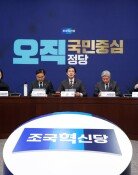The Risk Premium For Foreign Currency Denominated Bond Has Decreased.
The Risk Premium For Foreign Currency Denominated Bond Has Decreased.
Posted February. 10, 2003 00:11,
The risk premium for foreign currency denominated bonds issued by Korean entities including foreign currency equalization bond still shows its stability despite the worsening of the nuclear issue of the North Korea.
On the 9th according to the financial circle, the risk premium for the foreign currency denominated bond with the maturity of 10 years issued by the Government in 1998 amounted to a 117bp (1bp corresponds to 0.01%) plus the yield of US Treasury Note last weekend.
It is higher than 108bp in November last year, but has been slightly improved than 117bp at the end of January.
As a risk premium indicates an additional profitability than the yield of US Treasury Note, it decreases due to the enhancement of the creditworthiness of issuer.
In addition, the risk premium of the KDB bond with the maturity of 10 years issued by the Korea Development Bank last year amounted to 126bp last weekend, a slight decrease from 129bp at the end of November last year.
The forecast is also announced that it would have been more improved without the issue of transparency caused by the secret remittance to the North Korea.
The risk premiums for foreign currency equalization bond and KDB bond are regarded as the bench-marks indicating the short-term creditworthiness of Korea while the credit ratings of credit assessment institutions including the Moodys are based on the long-term creditworthiness for 6 to 12 months.
Mr. Lee Hae-ryong, the Deputy General Manager of the Korea Development Bank said, The credit rating of credit assessment institute does not decide the absolute level of the cost of fund of the borrower, but there occurs the difference of the cost of capital among institutions with the same credit rating.
Yong-Ki Kim ykim@donga.com







